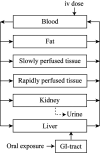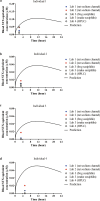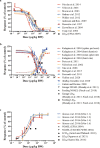Integrating In Vitro Data and Physiologically Based Kinetic Modeling to Predict and Compare Acute Neurotoxic Doses of Saxitoxin in Rats, Mice, and Humans
- PMID: 37478462
- PMCID: PMC10399293
- DOI: 10.1021/acs.est.3c01987
Integrating In Vitro Data and Physiologically Based Kinetic Modeling to Predict and Compare Acute Neurotoxic Doses of Saxitoxin in Rats, Mice, and Humans
Abstract
Current climate trends are likely to expand the geographic distribution of the toxigenic microalgae and concomitant phycotoxins, making intoxications by such toxins a global phenomenon. Among various phycotoxins, saxitoxin (STX) acts as a neurotoxin that might cause severe neurological symptoms in mammals following consumptions of contaminated seafood. To derive a point of departure (POD) for human health risk assessment upon acute neurotoxicity induced by oral STX exposure, a physiologically based kinetic (PBK) modeling-facilitated quantitative in vitro to in vivo extrapolation (QIVIVE) approach was employed. The PBK models for rats, mice, and humans were built using parameters from the literature, in vitro experiments, and in silico predictions. Available in vitro toxicity data for STX were converted to in vivo dose-response curves via the PBK models established for these three species, and POD values were derived from the predicted curves and compared to reported in vivo toxicity data. Interspecies differences in acute STX toxicity between rodents and humans were found, and they appeared to be mainly due to differences in toxicokinetics. The described approach resulted in adequate predictions for acute oral STX exposure, indicating that new approach methodologies, when appropriately integrated, can be used in a 3R-based chemical risk assessment paradigm.
Keywords: neurotoxicity; physiologically based kinetic (PBK) model; quantitative in vitro to in vivo extrapolation (QIVIVE); risk assessment; saxitoxin.
Conflict of interest statement
The authors declare no competing financial interest.
Figures






Similar articles
-
Acetylcholinesterase Inhibition in Rats and Humans Following Acute Fenitrothion Exposure Predicted by Physiologically Based Kinetic Modeling-Facilitated Quantitative In Vitro to In Vivo Extrapolation.Environ Sci Technol. 2023 Dec 12;57(49):20521-20531. doi: 10.1021/acs.est.3c07077. Epub 2023 Nov 26. Environ Sci Technol. 2023. PMID: 38008925 Free PMC article.
-
Predicting points of departure for risk assessment based on in vitro cytotoxicity data and physiologically based kinetic (PBK) modeling: The case of kidney toxicity induced by aristolochic acid I.Food Chem Toxicol. 2016 Jun;92:104-16. doi: 10.1016/j.fct.2016.03.017. Epub 2016 Mar 23. Food Chem Toxicol. 2016. PMID: 27016491
-
Use of Physiologically Based Kinetic Modeling-Facilitated Reverse Dosimetry to Predict In Vivo Acute Toxicity of Tetrodotoxin in Rodents.Toxicol Sci. 2022 Apr 26;187(1):127-138. doi: 10.1093/toxsci/kfac022. Toxicol Sci. 2022. PMID: 35218365 Free PMC article.
-
Use of Physiologically Based Kinetic Modeling-Based Reverse Dosimetry to Predict in Vivo Toxicity from in Vitro Data.Chem Res Toxicol. 2017 Jan 17;30(1):114-125. doi: 10.1021/acs.chemrestox.6b00302. Epub 2016 Nov 9. Chem Res Toxicol. 2017. PMID: 27768849 Review.
-
Next generation physiologically based kinetic (NG-PBK) models in support of regulatory decision making.Comput Toxicol. 2019 Feb;9:61-72. doi: 10.1016/j.comtox.2018.11.002. Comput Toxicol. 2019. PMID: 31008414 Free PMC article. Review.
Cited by
-
Advancing Toxicity Predictions: A Review on in Vitro to in Vivo Extrapolation in Next-Generation Risk Assessment.Environ Health (Wash). 2024 May 9;2(7):499-513. doi: 10.1021/envhealth.4c00043. eCollection 2024 Jul 19. Environ Health (Wash). 2024. PMID: 39473885 Free PMC article. Review.
References
-
- World Health Organization Toxicity equivalency factors for marine biotoxins associated with bivalve molluscs; Technical paper; Joint Food and Agriculture Organization of the United Nations/World Health Organization: Rome, Italy, 2016; https://apps.who.int/iris/bitstream/handle/10665/250663/9789241511483-en....
-
- Alonso E.; Alfonso A.; Vieytes M. R.; Botana L. M. Evaluation of toxicity equivalent factors of paralytic shellfish poisoning toxins in seven human sodium channels types by an automated high throughput electrophysiology system. Arch. Toxicol. 2016, 90, 479–488. 10.1007/s00204-014-1444-y. - DOI - PubMed
-
- Scientific Opinion of the Panel on Contaminants in the Food Chain on a request from the European Commission on Marine Biotoxins in Shellfish – Saxitoxin Group. EFSA J. 2009, 1019, 1–76.
-
- Barrientos R. G.; Hernández-Mora G.; Alegre F.; Field T.; Flewelling L.; McGrath S.; Deeds J.; Chacón Y. S.; Rojas Arrieta K.; Vargas E. C.; Artavia K. B.; Stacy B. A. Saxitoxin poisoning in green turtles (Chelonia mydas) linked to scavenging on mass mortality of Caribbean sharpnose puffer fish (Canthigaster rostrata-Tetraodontidae). Front. Vet. Sci. 2019, 6, 466.10.3389/fvets.2019.00466. - DOI - PMC - PubMed
Publication types
MeSH terms
Substances
LinkOut - more resources
Full Text Sources

